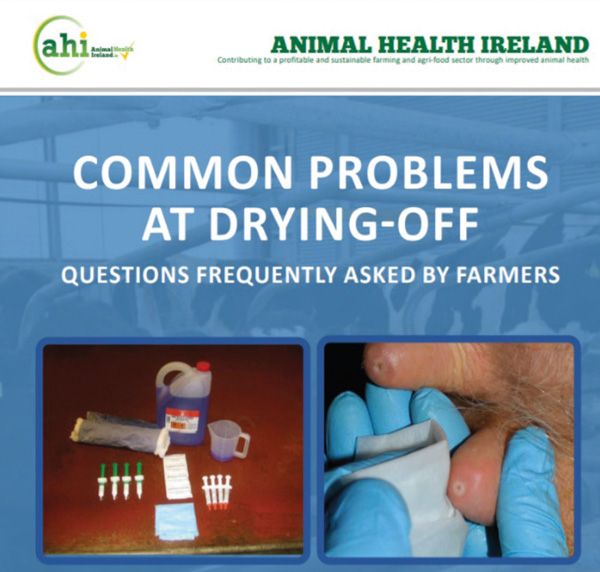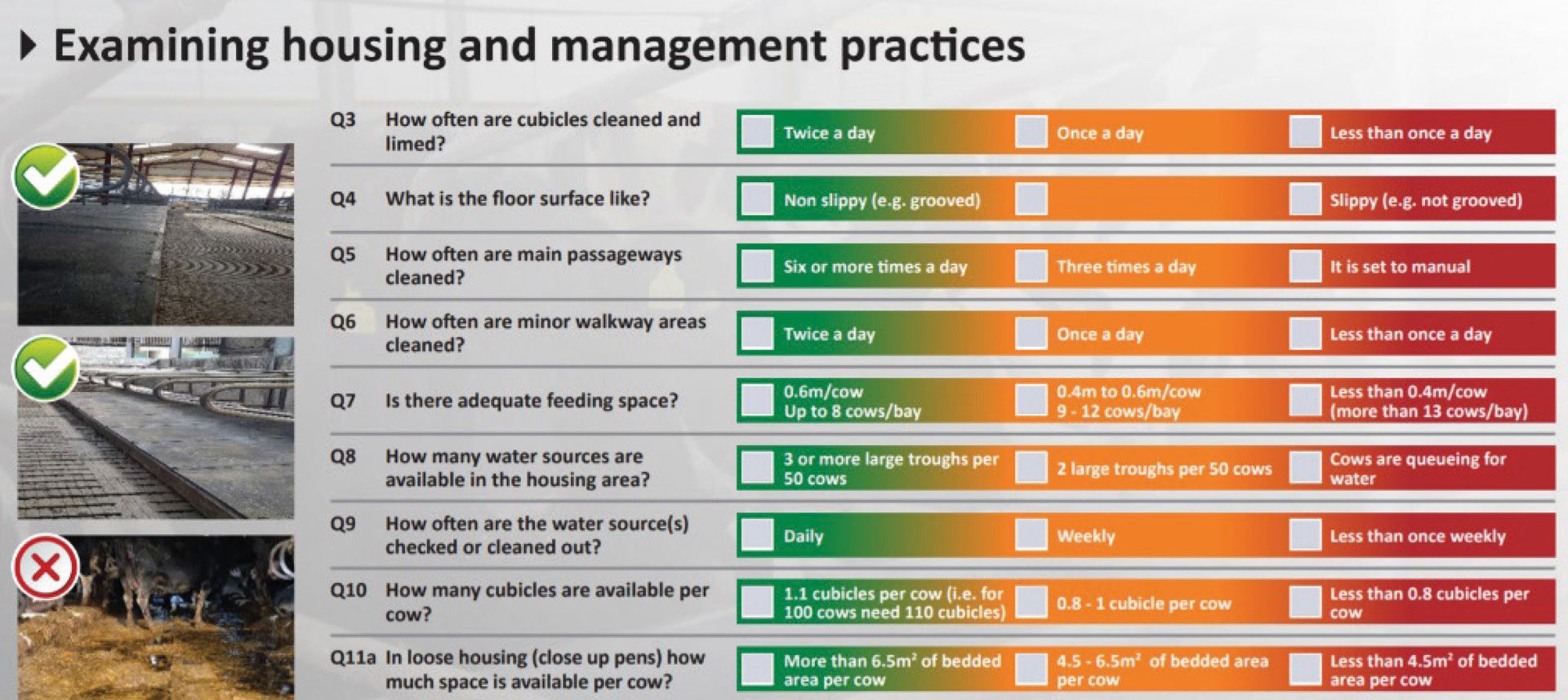The CellCheck Tool Box – veterinary and farmer resources for the dry period
Michelle McGrath BAgriSci MAnSci DipSFP MVB, assistant CellCheck programme manager, Animal Health Ireland (AHI), offers an overview of the resources AHI are providing to help veterinary practitioners and farmers prepare for the new legislation in 2022
Historically, when farmers had a mastitis problem on their farm, they only contacted their veterinary practitioners about clinically sick animals. However, as farm animal practice evolves, there is an opportunity for the veterinary practitioner to play a more proactive role in mastitis control and be much more involved in prevention as well as treatment. Working with the farmer’s other farm service providers to offer a multidisciplinary approach will also lead to a better outcome.
A key objective of the CellCheck programme, for the last year in particular, has been to develop practical resources that will help both the farmer and the veterinary practitioner to be better prepared for the new legislation in 2022. One change that this legislation will bring is that dry cow antibiotics may only be prescribed for cows with evidence of infection. This will mean a massive change in mindset for both farmers and veterinary practitioners.
Two years ago, when I left practice to work with AHI, I had concerns about what this change could mean from an animal welfare point of view, because dry cow therapy has been used as a safety net against new infections for many years. However, having seen how other countries and plenty of Irish farmers have dealt with the move away from blanket dry cow therapy, to selective dry cow therapy (SDCT), I am confident that with the proper approach and cow selection, SDCT can be successful in Ireland too.
It is with these objectives in mind that the CellCheck Technical Working and Implementation groups have recently developed and delivered a new suite of resources to help farmers prepare for SDCT and put in place procedures that will help minimise the risk involved. With the increasing levels of antimicrobial resistance (AMR), it is no longer acceptable to use antibiotics where they are not needed, or to compensate for poor management. This article outlines some of the new resources that are easily accessed on the AHI website.
Leaflets
'Common problems at drying off' is a leaflet from AHI which answers questions frequently asked by farmers and deals with the problems they encounter. It is important that the advice farmers get from veterinary practitioners or advisors is consistent, to avoid mixed messaging which can be frustrating for farmers. The answers in this leaflet are based on the most recent research in these areas, or in the absence of research, an expert consensus from the CellCheck Technical Working Group.
“How do I prevent new mastitis infections at drying off?” is a step-by-step leaflet, outlining the key points when it comes to hygienic intramammary infusion. Hygienic administration is essential, whether using antibiotic dry cow tubes, internal teat sealant or both, to prevent bacteria entering the quarter and causing infection. Good hygiene will prevent new infections and the standard of hygiene at drying off will influence the incidence of new mastitis infections in the following lactation.

AHI’s leaflet on common problems at drying off.
Winter housing checklist
The dry period is a crucial time, when new udder infections can be picked up from the environment leading to mastitis, even though clinical signs may not be seen until the start of the next lactation. AHI provides a self-assessment checklist that helps to make farmers more aware of the hygiene of their cows and their sheds, and to highlight areas that may need improvement to minimise the risk of new udder infections occurring. The farmer can complete this checklist themselves or with their advisor or veterinary practitioner.
It could be used as a conversation starter, especially on farms where you know that housing is a problem, but find it difficult to approach this topic with the farmer. The answers are colour-coded, using a traffic-light system showing the ranges that can occur within each category. It gives the farmer an indication of areas where improvement may be necessary but also highlights their strengths. Many of the changes can be easily made and do not require a significant investment to see an improvement.
The checklist is accompanied by a notes section, intended to provide guidance when reviewing cow and cubicle hygiene. It outlines briefly what the checklist answers mean in terms of mastitis control, such as the importance of maintaining a clean, dry, comfortable environment for cows during the entire dry period. Poor cow cleanliness, as demonstrated by hygiene scoring, has been shown to significantly increase the risk of new clinical mastitis infection, particularly infections caused by E. coli. If greater than 20 per cent of the cows are in the red category for hygiene scoring, then the risk of mastitis for the herd is higher.
Good cubicle design leads to maximum cubicle usage, which in turn leads to cows that are cleaner and more comfortable. Taking the time to observe how cows are behaving in the shed can be very informative; for example, how many are standing in the cubicles completely, or half-on half-off? This may indicate that the cows find it difficult to lie down or get up and avoid doing so. One reason for this may be due to inadequate space in front of their heads, preventing them from lunging forward when getting up. The distance from the brisket board to kerb is important, and when correct will result in cleaner cows. This can be assessed by checking their lying position on the cubicles, or checking where the faeces are. The height and location of the neck rail and cubicle slope are also important. As these measurements vary depending on cow type, it is important to discuss them in detail with your herd owner. Recommended measurements are available from Teagasc.
The loafing areas are defined as non-lying and non-feeding areas that allow calving cows freedom for normal behaviour, encouraging cows to spread out, reducing faecal contamination and bullying. The recommended area is 2 sq. metres per cow. Passages with dead ends should be avoided in cubicle houses. Adequate passage widths are important for cows to move about easily, with a minimum of three metres between two rows of cubicles, four metres alongside feed barriers or 4.3 metres if cows are backing out from a cubicle near the feed barrier. Having adequate feeding space and easy access to a clean water source are essential to avoid competition between cows and the build-up of dung in the passageways from cows queuing to feed or drink.
Dry cow nutrition is an important element of a mastitis control plan because it can influence the cows’ immune status, both during the dry period and in the subsequent lactation. It is important to give correct advice on the dry cow diet to avoid any issues arising, e.g., over-thin or over-fat cows, and metabolic diseases all increase the risk of mastitis. Good ventilation and natural light in the dry cow house provides a dry atmosphere and reduces the chance of bacteria surviving and multiplying in the shed.
The challenges involved in managing dry cows in straw yard systems, especially during the high-risk periods are outlined in the checklist, and advice is given on how to overcome them. For example, regular removal of dung will avoid build-up of bugs in the cows' environment and help keep cows clean, minimising the risk of mastitis. Carrying out a kneel test in the straw pen is a good way to determine if the bed is dry enough or not. If your knees are damp or wet having knelt on the straw bed, this means the bed is not dry enough and needs more bedding. Approximately 55kg of straw is needed per cow per week for adequate bedding. As a guide, a standard round bale contains approximately 150kgs of straw. In particular, extra attention should be paid to cows in the 24hrs before and after calving. Good management of the cow and their housing around this time is important to ensure cows are healthy and to reduce the risk of mastitis in the upcoming lactation.

A winter housing checklist for mastitis control from AHI.
Other tools in the CellCheck ‘toolbox’
Videos
A range of videos are available on the CellCheck page of the AHI website and are a useful resource for both veterinary practitioners and farmers. Among the videos is a farmer case study and his approach to drying off, as well as what he does in advance of drying off and during the dry period, which now means that only 10 per cent of his high-yielding herd are treated with dry cow antibiotics. Don Crowley, a dairy advisor in Teagasc, presents the 'Top tips for Managing your Winter Housing'.
Professor Martin Cormican, the National Clinical Lead on the Antimicrobial Resistance & Infection Control Team in the HSE Galway, presents a video that helps explain AMR to farmers. He describes the importance of responsible antimicrobial use in human and animal health and what will happen if we don’t use antibiotics more prudently. Antibiotics should be still used to treat sick animals, and if we all adopt the motto of ‘as little as possible but as much as necessary’ it will make a big difference in tackling AMR.
Farmers’ testimonials on milk recording
From 2022, individual cow information is going to be key to allow veterinary practitioners to prescribe dry cow antibiotic in particular. Milk recording results are currently accepted internationally as best-practice in identifying cows at the end of their lactation with probable infected quarters, and for prescribing dry-cow antibiotic treatment. While it may be possible to improve the accuracy of diagnosing infection through the additional measures of clinical disease history, bulk tank SCC trends and milk culture results, milk recording is a mainstay of this decision-making process, due to the relative practicality of delivery and multiple additional benefits to farm management.
Currently, less than 50 per cent of farmers in Ireland milk record, which is much less than many of our European counterparts, highlighting the urgent need for more farmers in Ireland to begin milk recording. It is important to highlight the benefits of milk recording beyond a requirement for a prescription from 2022, to motivate farmers to milk record. Benefits include mastitis management, maximising productivity and efficiency, and better culling and breeding decisions. A recent Teagasc study has shown that milk yields and gross margins were 13.5 and 11.3 per cent higher respectively and bulk tank SCCs were 26.3 per cent lower in milk recording herds, when compared to matched non-milk recording herds. CellCheck continues to work on communicating the message about the multiple benefits of milk recording. The dairy co-ops participating in the CellCheck Implementation Group, recently developed farmer testimonials about milk recording, including their reasons for starting and what they see as the benefits from milk recording. These are also available on the AHI website and are a useful tool when trying to persuade farmers to begin milk recording. We would encourage veterinary pracititioners to use every on-farm opportunity to highlight the benefits of milk recording to their clients.
















